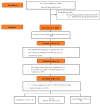Effects of a 12-Month Hybrid (In-Person + Virtual) Education Program in the Glycemic Status of Arab Youth
- PMID: 35565727
- PMCID: PMC9103307
- DOI: 10.3390/nu14091759
Effects of a 12-Month Hybrid (In-Person + Virtual) Education Program in the Glycemic Status of Arab Youth
Abstract
This 12-month school-based intervention study investigated the effects of hybrid educational lifestyle modifications on glycemic control among Saudi youth with different glycemic statuses. A total of 2600 Arab adolescents aged 12−18 years were recruited from 60 randomly selected schools. Anthropometrics, blood glucose, and HbA1c were measured pre- and post-intervention. Participants were grouped according to baseline HbA1c into normal, prediabetes, and diabetes groups. All participants received lifestyle education at base line and at every 3-month interval to improve diet and exercise behavior. Diabetic and prediabetic participants received a tailored lifestyle intervention. Post-intervention, 643 participants were analyzed as follows: 20 participants from the diabetes group, 39 from prediabetes, and 584 from the normal group. A modest but significant improvement in the glycemic status of diabetic and prediabetic participants was observed, but not in the normal group. In the diabetes group, 11 (55%) participants achieved normal HbA1c levels, 5 had prediabetes levels, and only 4 remained within diabetes HbA1c levels. In the prediabetes group, 34 (87.2%) participants achieved normal HbA1c levels, while 2 (5.1%) participants remained prediabetic and 3 (7.7%) had diabetes HbA1c levels (p < 0.001). This hybrid lifestyle intervention program modestly reduces the risk of T2DM among youth with elevated HbA1c levels. The challenge of sustaining interest in adopting lifestyle changes for a longer duration should be addressed in further studies in this population.
Keywords: adolescents; arab; diabetes; obesity; pediatrics.
Conflict of interest statement
The authors declare no conflict of interest.
Figures
Similar articles
-
Reversal of Prediabetes in Saudi Adults: Results from an 18 Month Lifestyle Intervention.Nutrients. 2020 Mar 18;12(3):804. doi: 10.3390/nu12030804. Nutrients. 2020. PMID: 32197404 Free PMC article. Clinical Trial.
-
Mobile Delivery of the Diabetes Prevention Program in People With Prediabetes: Randomized Controlled Trial.JMIR Mhealth Uhealth. 2020 Jul 8;8(7):e17842. doi: 10.2196/17842. JMIR Mhealth Uhealth. 2020. PMID: 32459631 Free PMC article. Clinical Trial.
-
Identification of Education Models to Improve Health Outcomes in Arab Women with Pre-Diabetes.Nutrients. 2019 May 18;11(5):1113. doi: 10.3390/nu11051113. Nutrients. 2019. PMID: 31109110 Free PMC article.
-
Effectiveness of Dietitian-Involved Lifestyle Interventions in Diabetes Management Among Arab Populations: A Systematic Review and Meta-Analysis.Nutrients. 2024 Dec 11;16(24):4283. doi: 10.3390/nu16244283. Nutrients. 2024. PMID: 39770905 Free PMC article.
-
Identifying Prediabetes and Type 2 Diabetes in Asymptomatic Youth: Should HbA1c Be Used as a Diagnostic Approach?Curr Diab Rep. 2018 Jun 4;18(7):43. doi: 10.1007/s11892-018-1012-6. Curr Diab Rep. 2018. PMID: 29868987 Free PMC article. Review.
Cited by
-
Validity and reliability of the Arabic sedentary behavior questionnaire among university students aged between 18-30 years old.BMC Public Health. 2023 Jan 18;23(1):128. doi: 10.1186/s12889-023-15030-1. BMC Public Health. 2023. PMID: 36653773 Free PMC article.
-
Circulating fibroblast growth factor-21, Omentin-1, and betatrophin and their association with metabolic parameters in Saudi adolescents post 12-month lifestyle change program.BMC Pediatr. 2025 Jul 1;25(1):482. doi: 10.1186/s12887-025-05833-z. BMC Pediatr. 2025. PMID: 40597046 Free PMC article.
-
Establishing the Prevalence of Osteomalacia in Arab Adolescents Using Biochemical Markers of Bone Health.Nutrients. 2022 Dec 16;14(24):5354. doi: 10.3390/nu14245354. Nutrients. 2022. PMID: 36558513 Free PMC article.
-
Perceived School Experience of Children and Adolescents With Type 1 Diabetes in the Kingdom of Saudi Arabia.Cureus. 2023 Aug 29;15(8):e44335. doi: 10.7759/cureus.44335. eCollection 2023 Aug. Cureus. 2023. PMID: 37779730 Free PMC article.
-
Dose Intervals and Time since Final Dose on Changes in Metabolic Indices after COVID-19 Vaccination.Vaccines (Basel). 2023 Nov 23;11(12):1746. doi: 10.3390/vaccines11121746. Vaccines (Basel). 2023. PMID: 38140151 Free PMC article.
References
MeSH terms
Substances
Grants and funding
LinkOut - more resources
Full Text Sources
Medical


